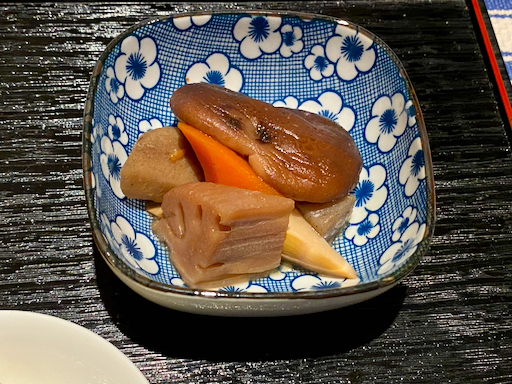On New Year’s eve, we started the evening with a plate of assorted sashimi, most of the sashimi came from “Riviera Seafood Club”, our most recent favorite source of “home freezer” sashimi or sashimi that we can store in the freezer here at home and thaw at any time we want sashimi. Since the portions are smaller than sashimi we can get from other sources, we can eat more than one kind of sashimi at a time. On the New Year’s plate (picture #2) we had chutoro tuna 中トロ, hamachi はまち, scollop ホタテ, and octopus leg タコの足 (which was from D’artagnan). I added wasabi with chopped wasabi plant stalk (from tube) and yuzu kocho 柚子胡椒 (from tube).
On New Year’s day, we had only coffee (cafe latte and macchiato with a bit of steamed cream) rather than our usual breakfast so we wouldn’t be too full for the large lunch we planned of “Ozhoni” お雑煮 New Year’s soup. As usual, I served the soup in real lacquer ware bowls (gift from my mother many many years ago) with a side of some New Year’s dishes I made (picture #3).
This year, I precooked all the vegetables and proteins that went into the soup. This included “gobo” burdock root 牛蒡, shiitake 椎茸, shimeji しめじ and wood ear 木耳 mushrooms, carrot 人参, daikon 大根, and “kinu-saya” 絹さや snow peas. The protein included sous vide chicken breast (a few slices) and poached shrimp. As usual, I encased the “mochi” 餅 rice cake in “abra-age” 油揚 deep fried tofu pouch (peaking out of the bottom right of the soup bowl). I made the broth from the dashi packs I usually use as well as by poaching the shrimp in the dashi broth. I seasoned it with x4 concentrated Japanese noodle sauce. By precooking the vegetables and the proteins, I had better control over cooking everything just right. It also made it possible for me to make a better arrangement of the ingredients in the final soup bowl serving. Just before serving, I added frozen yuzu zest which added a nice yuzu 柚子 citrus favor (picture #4).
The side dishes (picture #5) included the usual New Year’s dishes I like to make including: salmon kelp roll 酒の昆布巻き, salmon “Russian” marinade 鮭のロシア漬 garnished with “ikura” イクラsalmon roe, daikon namasu 大根なますand poached shrimp.
We also had a few small glasses of sake with this as a libation to the New Year. Now, this evening we will be hitting the Sushi Taro Osechi box すし太郎お節箱. The below is a preview (pictures #6 and 7).
We expect some good New Year’s feast to come with the osechi box. Already salivating!!


























































